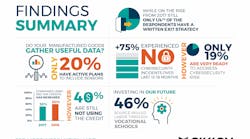The IoT can enable manufacturers to enhance field service, optimize plant maintenance and smartly manage inventory. We know this. But in the 2018 Manufacturing Report from Sikich, fewer than 10 percent of those surveyed currently use IoT technologies. Further, 30 percent said they have no clear understanding of the Internet of Things.
Yikes.
“Manufacturers of all sizes can benefit from the Internet of Things, but too many lack the necessary understanding of the benefits and fail to embrace these transformative technologies,” says Jerry Murphy, partner-in-charge of Sikich’s manufacturing-and-distribution practice. “As a result, many manufacturers and distributors miss out on significant operational improvements and efficiency gains across the supply chain, which can put them at a competitive disadvantage.”
We chatted with Jerry to learn more…
Smart Industry: Who did you survey?
Jerry: The Sikich 2018 Manufacturing Report includes responses from more than 200 participants across a wide range of industrial sectors, including metal-fabrication, industrial equipment, food and beverage, OEM equipment, chemicals and petroleum, automotive, plastics and wholesale/distribution.
Smart Industry: Were you surprised that just 10 percent of respondents use IoT technologies?
Jerry: The survey found that a meaningful number of organizations still lack awareness of the benefits of IoT, which means there’s significant room for increased adoption. It is important to note that in addition to the 9 percent already using IoT technology, 14 percent are currently implementing this technology and more than one-third of respondents are monitoring developments in IoT. Within the next year, we expect more manufacturers to adopt IoT technologies as they learn more about the benefits.
Smart Industry: What is the reason for that low adoption?
Jerry: Many companies may think their IT systems are not ready to handle IoT technologies. However, most ERP systems are currently IoT-ready and have gateways to receive information from sensors.
Smart Industry: What do you find troublesome in these results?
Jerry: Only 19 percent of respondents said they’re “very ready” to address a cybersecurity risk, while 63 percent said they are only “somewhat ready.” IoT technologies have many benefits, yet by increasing the amount of technology in a manufacturing operation, they can also create cybersecurity vulnerabilities. As more manufacturers begin to implement IoT technologies, they must ensure their environments are secure. They must practice due diligence when selecting vendors. Additionally, manufacturers should have incident-response plans that they can put into action if breaches happen.
Smart Industry: What do you find most encouraging?
Jerry: Results from this year’s survey indicate more manufacturers are realizing the benefits of R&D tax credits. Sixty percent of respondents say they’re using R&D tax credits, compared to 52 percent in 2017. Since new-product or service development was identified by respondents as the second biggest opportunity for growth, R&D investment will likely continue to increase. These tax credits make manufacturers more competitive by giving them more money they can use to grow.


